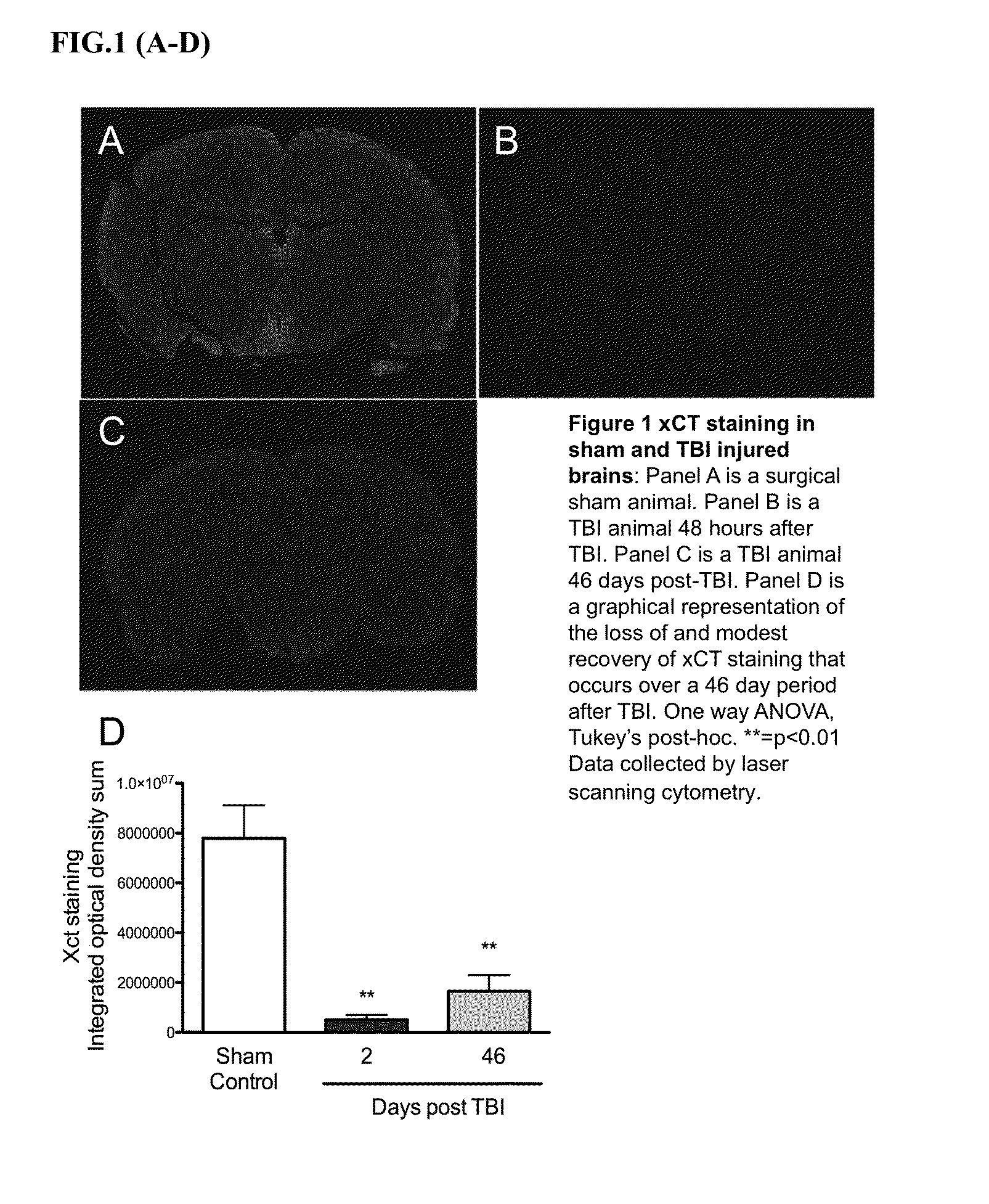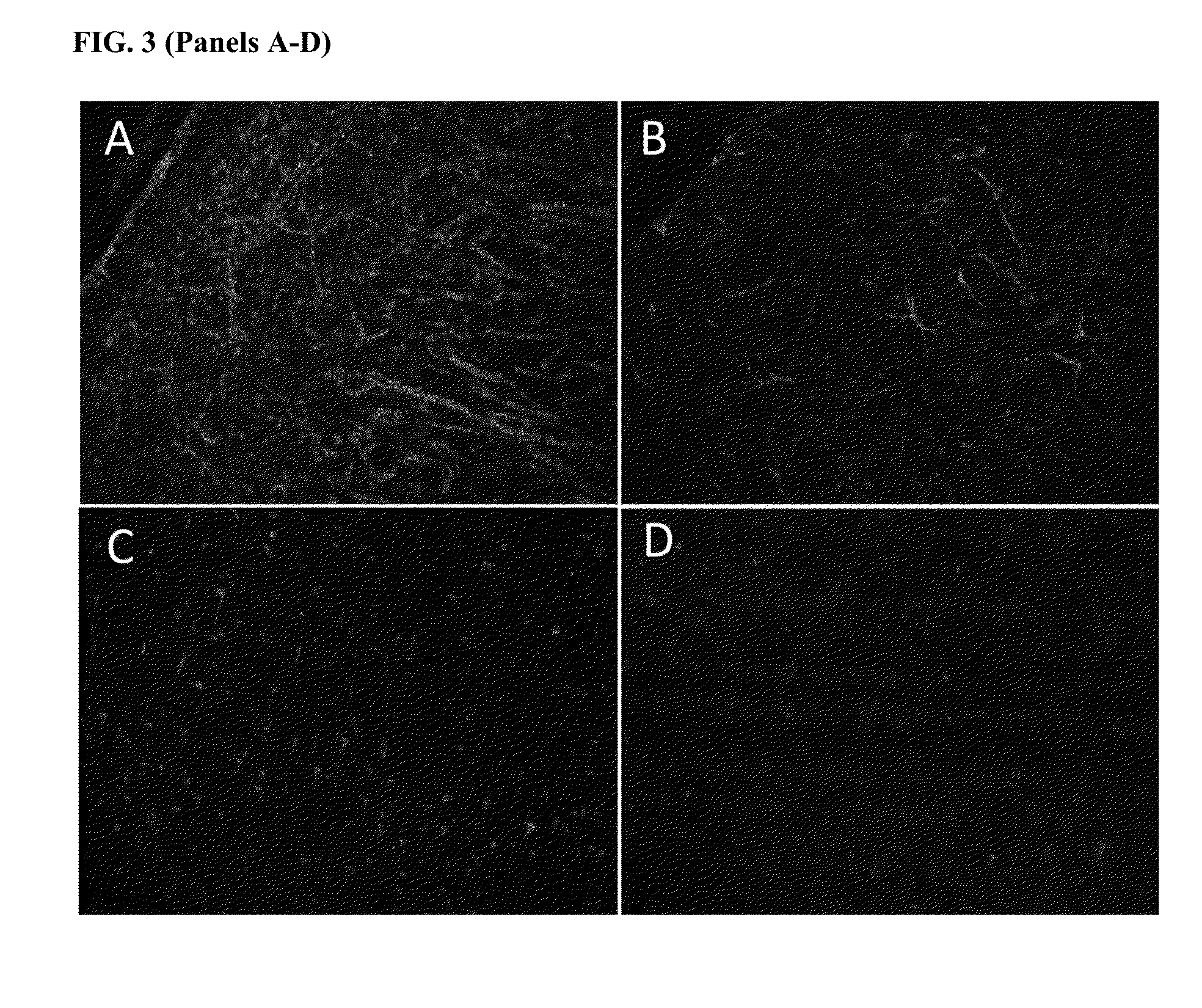Detection of Brain Injury
a brain injury and brain injury technology, applied in the field of brain injury detection, can solve the problems of tbi-caused neuronal damage or cte progression, no non-invasive diagnostic methods or tools, synaptic dysfunction and loss, neurite retraction and axonal degeneration, etc., to improve the long-term prognosis and good or poor long-term survival prospects
- Summary
- Abstract
- Description
- Claims
- Application Information
AI Technical Summary
Benefits of technology
Problems solved by technology
Method used
Image
Examples
example 1
Gene Array Analysis Before and after TBI in Rodent Model
[0087]System xc− is a cystine / glutamate antiporter comprised of two distinct subunits xCT and 4F2hc (SLC3A2) and a member of the heteromeric amino acid transporter (HAT) family. Under physiological conditions, System xc− mediates the exchange of extracellular L-cystine and intracellular L-glutamate across the plasma membrane. In the CNS, the influx of L-cystine represents the critical rate limiting step in the biosynthesis of glutathione (GSH) while the concurrent efflux of L-glutamate serve as a non-vesicular route of excitatory neurotransmitter release to initiate excitatory amino acid (EAA) signalling. GSH serves as the key cellular antioxidant responsible for scavenging reactive oxygen species (ROS) that develop as a result of physiological cellular metabolism. Thus a global loss of System xc− activity would result in decreased intracellular glutathione levels, leaving the CNS vunerable to oxidative stress due to an increas...
example 2
miRNA Expression Profiles of Oxidative Stress and Antioxidant Defense Genes
[0089]To follow up this study, we performed a gene array analysis to determine if oxidative stress genes up-regulate to compensate for the loss of GSH (FIG. 4). From this study we found exactly the opposite occurred; TBI resulted in a down-regulation of key anti-oxidant defense genes leaving neurons critically susceptible to ROS damage. In an effort to elucidate the mechanism of how the xCT subunit and anti-oxidant defense genes were down-regulated by TBI we performed a microRNA (miRNA) expression profile study on rat (R. norvegus) cortical brain tissue following neuronal injury in a lateral fluid percussion TBI model (FIG. 5). In light of our prior findings, we chose miRNAs that specifically interact with anti-oxidant defense genes and xCT. A specific cluster of miRNAs that were significantly (2-13 fold) up or down regulated as a result of TBI was discovered (Table 3). Further studies indicate all of these h...
example 3
miRNA Expression Profiles of Human Peripheral Blood Plasma
[0090]Approximately 3 mL of blood was collected from each subject and processed as described below. Total RNA was isolated and prepared from 200 μL plasma according to the miRNeasy Serum / Plasma Kit (50) protocol according to the manufacturer's instructions (Qiagen). cDNA was prepared using the isolated total RNA. Real-time PCR was performed using the Qiagen miScript SYBR Green PCR kit and custom miScript miRNA PCR Array on a Bio-Rasd iQ5 cycler. Data analysis was performed using the Qiagen Data Analysis Center. The following plasma samples were obtained:
Sample SourceDescriptionn =ControlNo TBI, non-athlete14Football PlayersNo TBI with 3 months49Soccer PlayersNo TBI with 3 months19Acute TBI24-72 post-TBI4Chronic TBI3 months post-TBI6
All plasma samples were obtained by voluntary donation according to the Institutional Review Board protocols of The University of Montana. Samples were obtained at random (control group), from stud...
PUM
| Property | Measurement | Unit |
|---|---|---|
| time | aaaaa | aaaaa |
| Northern blot | aaaaa | aaaaa |
| size | aaaaa | aaaaa |
Abstract
Description
Claims
Application Information
 Login to View More
Login to View More - R&D
- Intellectual Property
- Life Sciences
- Materials
- Tech Scout
- Unparalleled Data Quality
- Higher Quality Content
- 60% Fewer Hallucinations
Browse by: Latest US Patents, China's latest patents, Technical Efficacy Thesaurus, Application Domain, Technology Topic, Popular Technical Reports.
© 2025 PatSnap. All rights reserved.Legal|Privacy policy|Modern Slavery Act Transparency Statement|Sitemap|About US| Contact US: help@patsnap.com



